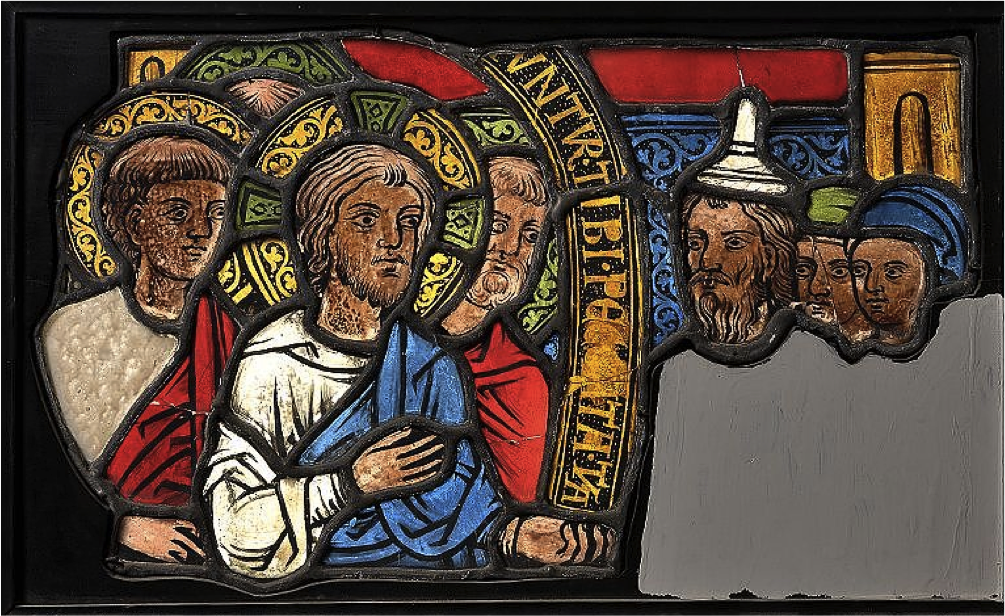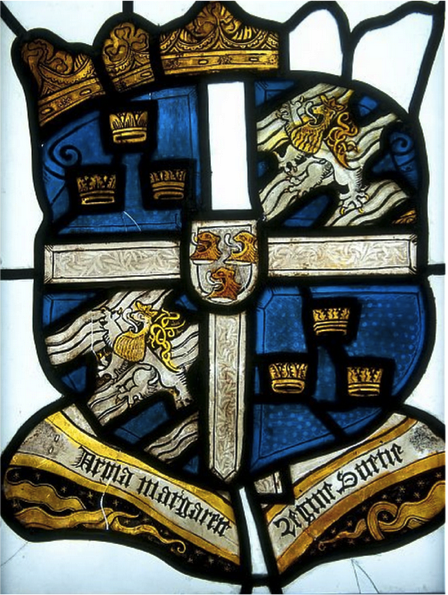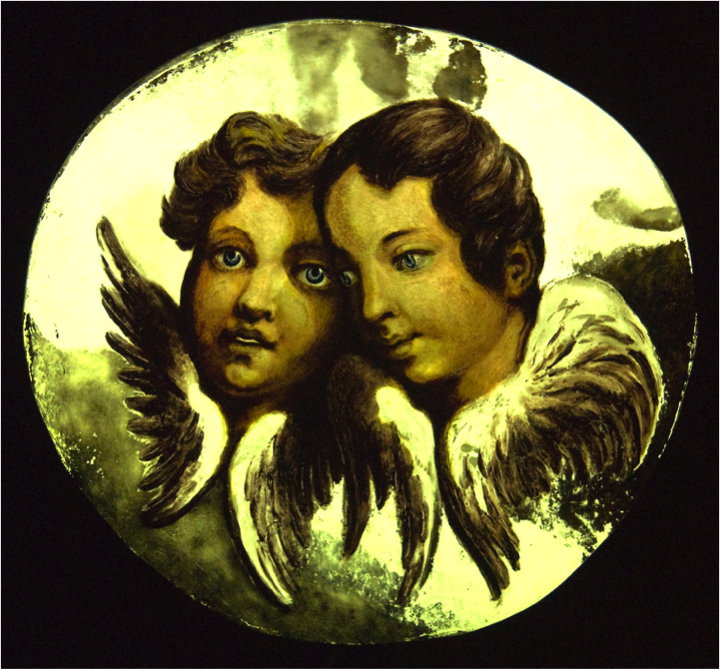Northernmost lights - stained glass in Sweden
 Stained glass and ecclesiastical buildings seem inseparable and have been for over a millennium. Archaeological excavations at the monastic sites at Monkwearmouth and Jarrow brought to light coloured, but unpainted, window glass from the Anglo-Saxon period. The Abbot of Monkwearmouth, Benedict Biscop, brought in 675 glaziers from Gaul to teach the Saxons how to make glass.
Stained glass and ecclesiastical buildings seem inseparable and have been for over a millennium. Archaeological excavations at the monastic sites at Monkwearmouth and Jarrow brought to light coloured, but unpainted, window glass from the Anglo-Saxon period. The Abbot of Monkwearmouth, Benedict Biscop, brought in 675 glaziers from Gaul to teach the Saxons how to make glass.
In Sweden, the earliest production of glass, dated to the middle of the 12th century, took place in the vicinity of monasteries such as Alvastra, Nydala and Varnhem. They were founded by cistercian monks travelling north from the mother church at Citeaux.
French stonemasons also arrived during two periods in the last half of the 13th century and built the Cathedral at Uppsala. Although it is highly probable that the Cathedral had, with its connection to France and cultural exchanges through trade and religious institutions, stained glass windows in medieval times, there are no surviving panels. An orange-coloured piece of glass, still in its masonry fitting, is thought to be the only surviving fragment of the original glazing scheme. (A - above right)
It is on the Island of Gotland in the Baltic sea that the majority of surviving panels are found. Of 165 figurative panels of medieval stained glass only eleven are extant in parish churches on the mainland. Visby, the major port on the island, was together with the German towns of Lübeck, Dortmund and Soest, one of the fourteen ports making up a forerunner to the Hanse trading alliance, with Visby in the early middle ages regarded as important, and as wealthy, as London and Paris. From the 11th to the middle of the 14th century over one hundred churches were built on Gotland.
 The reason for the medieval glass still remaining on the island could be attributed to a decline in Gotland’s economic boom. When the congregations on the mainland could afford to re-build their churches to reflect developments in architecture, with perhaps an increase in window size to allow more light, the parishes on Gotland could not afford to ‘improve’ their churches. A technical advance in ship building, with larger vessels from Lübeck, Riga and Tallinn being able to by-pass the port of Visby, contributed to the decline in wealth for the islanders. The period during which the building of churches on Gotland took place has glazing schemes predominantly from Hanse towns in Western and Northern Germany attributed as inspirational sources.
The reason for the medieval glass still remaining on the island could be attributed to a decline in Gotland’s economic boom. When the congregations on the mainland could afford to re-build their churches to reflect developments in architecture, with perhaps an increase in window size to allow more light, the parishes on Gotland could not afford to ‘improve’ their churches. A technical advance in ship building, with larger vessels from Lübeck, Riga and Tallinn being able to by-pass the port of Visby, contributed to the decline in wealth for the islanders. The period during which the building of churches on Gotland took place has glazing schemes predominantly from Hanse towns in Western and Northern Germany attributed as inspirational sources.
The oldest panels, from the period 1230-1280, are found in the churches of Dalhem and Endre with Lyechurch having the most extensive cycle consisting of 34 panels. The church at Alskog has five panels dated to 1270 believed to be in an English-Norwegian style. The iconography in all churches is overwhelmingly from the New Testament. (B - above left)
Not only artistic influences but also new techniques travelled north. Silver stain, the use of silver nitrate to colour white glass yellow or blue glass green, had it’s first documented use in window glass in Northern France in 1313 and is from then on widely used across Europe. The abrading, or etching, of flashed glass is a method by which a thin layer, most commonly of red glass, is removed to reveal the underlying white glass. Abraded red glass is found in panels at Lye Church, dated to 1325, and also in a panel from Hablingbo, now in Gotland's Museum, of a slightly later date.
 The reformation of the Swedish Church took place in the last three quarters of the 16th century with little stained glass produced from then on. A few roundels and heraldic shields are survivors from the post medieval period with one example being that of Queen Margareta Leijonhufvud, wife of King Gustaf Wasa. The glass, now at the History Museum in Stockholm, originally came from the Cathedral of Västerås and probably dates from the rebuilding of the church 1537-1550. (B - right)
The reformation of the Swedish Church took place in the last three quarters of the 16th century with little stained glass produced from then on. A few roundels and heraldic shields are survivors from the post medieval period with one example being that of Queen Margareta Leijonhufvud, wife of King Gustaf Wasa. The glass, now at the History Museum in Stockholm, originally came from the Cathedral of Västerås and probably dates from the rebuilding of the church 1537-1550. (B - right)
For glass of a later date we have to move to the middle of the 19th century when the choir at the Uppsala cathedral was finally restored following a fire in 1702 which had devastated most of central Uppsala and reached the Cathedral. Influences from both England, where A W N Pugin was in the forefront of the Gothic Revival, and France where Violett-le-Duc revived interest in medieval design and crafts, led the architect Per Axel Nyström to recommend the installation of stained glass to complement the murals that were going to be painted for the choir of the Cathedral. Nyström envisaged the murals to depict the life of King Gustav Wasa who, with his three wives, is buried in the crypt below a sarcophagus in the choir.
The design and painting of the new glass was carried out by John Way, court painter and professor at the Art Academy in Stockholm. In 1820 Way established a workshop equipped with kilns to enable him to fire painted glass. The designs for the five windows are symbolic representations of the life of King Gustav with e.g. spearheads encompassed by a bay leaf wreath signifying the liberation of Sweden from Danish occupation in which was instrumental. Way ordered blue and purple crown glass from England but declared that the white glass could be sourced in Sweden.
 The lancets of the choir were in 1841 filled with frosted glass painted with black tracing lines and silver stain and had cherubs and stylised foliage designs in the tracery. The windows were removed during the restoration of the Cathedral in 1889 and replaced by figurative panels. These had by 1976 suffered severe paint loss and Way’s glass was brought out of storage to be used as templates for new glass for the choir. (D - left)
The lancets of the choir were in 1841 filled with frosted glass painted with black tracing lines and silver stain and had cherubs and stylised foliage designs in the tracery. The windows were removed during the restoration of the Cathedral in 1889 and replaced by figurative panels. These had by 1976 suffered severe paint loss and Way’s glass was brought out of storage to be used as templates for new glass for the choir. (D - left)
Production of new stained glass in Sweden at the end of the 19th century was concentrated in three workshops. The first of which, and specialising in church windows, is N. P. Ringström AB Konstglasmästeri, was established in 1886 and is still operating today. Two years later, in 1888, two German glass painters, Adolf Neumann and August Vogel started Stockholms Glasmålnings- & Konstglasmästeri (Stockholms Glasmåleri) with Fredrik Gullich. Neumann and Vogel were technically brilliant glass painters who had worked at Rörstrands porcelain factory. Their work can be seen in the cathedrals in Uppsala, Skara, Växjöand Strängnäs.
The same year Svenska Glasmåleri AB was set upby Reinhold Callmander, a teacher of art with several trips to Germany and France to study glass painting behind him. For the next 34 years Callmander produced a large number of windows. Despite his trips to the continent it is clear that many windows made by his company over time suffered severe paint loss. In this he was not alone. During the 19th century, with its prolife ration of stained glass production, several English companies also found that many of their windows after a relatively short time had to be replaced. Paint loss can result from the glass paint itself being too course or having incorrect proportions of metal oxide and flux (ground glass). It could also be the case of firing the paint in too low a temperature for it to fuse with the base layer. Water, apart from destruction by human beings, is the most prolific destroyer of stained glass. Depending on the composition of the glass it can cause corrosion of both the base glass and the paint, especially if it has been badly fired, the coefficient of thermal expansion being different from the base layer or having a pitted surface. Condensation forming on the inside of a window can penetrate the paint and with fluctuations in temperature will expand and contract and cause deterioration. Callmander’s large south transept window at Uppsala, installed in 1892, started showing signs of the paint flaking and falling off as early as 1920 and is now undergoing conservation. It will be installed behind protective glazing to prevent further paint loss.
Clearly domestic companies were not only ones active during this period of stained glass revival. German and French glazing companies delivered painted glass to important ecclesiastical buildings. The stained glass of Sweden is therefore a product of collaboration and trade from across Europe, with peoples crossing land and sea to deliver, and share, goods, culture and knowledge. Alliances and associations that continue to prosper today.
Anette Wahlgren, MA University of York, is a stained glass conservator and heritage management consultant. A native of Sweden, she has worked at York Glaziers Trust, Cathedral Studios, Canterbury, and Uppsala Cathedral. She is also a director of Trace-in-Metal ltd and recently presented a paper on the history of Swedish Stained Glass at a colloquium in Gerona, Spain
The photographs illustrating this article are:
A Fragment of possible medieval glazing, Uppsala Cathedral. Photo: A Wahlgren
B The Raising of Lazarus, Dalhem church. Photo: Historiska Museet, Stockholm.
C Coat of arms, Queen Margareta Leijonhufvud. Photo: Historiska Museet, Stockholm.
D Cherubs by John Way, previously in the choir, Uppsala Cathedral. Photo: John Minary
The author of this article, Anett Wahlgren, is also a director of, Trace-in-Metal, the company waging a war on church metal theft,
You can find out more about what they offer on their website www.trace-in-metal.com
















